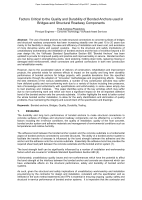Bridges

- Publication no: ABC2017-047-17
- Published: 20 April 2017
- PDF (free) Download
The use of bonded anchors to make structural connections to concrete surfaces of bridges and structural roadway components has been increasing steadily over the past 15 to 20 years due mainly to the flexibility in design, the ease and efficiency of installation and lower cost, and avoidance of more disruptive works and support systems.
Due to the structural and safety implications of unsatisfactory workmanship and installation of bonded anchors and the lack of evidence beyond a 50 year design life, the VicRoads Standard Specification Section 680 “Bonded Anchors” has been updated to provide for improved quality and practice and improved safety in service.
Bonded anchors are now being used in strengthening works, deck widening, holding down bolts, replacing missing or damaged steel reinforcement, shear connectors and general connections in both new construction and rehabilitation works. However, due to the accelerated nature of delivery of construction, rehabilitation and improvement projects, the potential exists for adverse effects to impact on the quality and long term durability performance of bonded anchors for bridge projects, with possible deviations from the specified requirements through the adoption of “innovative” methodologies and programming effects.
Despite the best intentions of the various stakeholders, a number of key construction activities may suffer from deficient quality and non-conforming work due to a variety of factors including time pressures, lack of knowledge and unfamiliarity with specifications and unfortunately in some cases simply due to bad practices and mistakes.
This paper identifies some of the key activities which may suffer due to non-conforming work and which can have a significant impact on the all important adhesive bond of the bonded anchor onto the concrete substrate. It further highlights the need to better control the whole bonded anchor installation, to allow for the early identification and elimination of quality problems, thus maintaining the integrity and overall intent of the specification and drawings.
